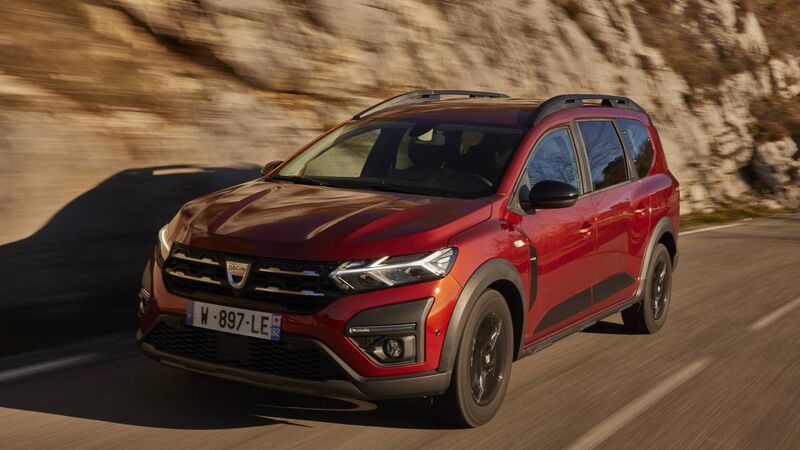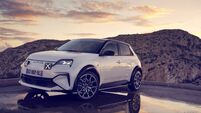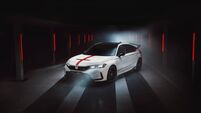Dacia Jogger review: Super seven-seater will have wide appeal

The Jogger, then, is another step on the road towards Dacia world domination – something, no doubt, the Ceausescu family dreamed of before they were offered the blindfolds and a last cigarette.
|
DACIA JOGGER |
|
|---|---|
|
|
★★★★☆ |
|
|
from €24,190 - €27,285 as tested |
|
|
an earthy one-litre three-pot petrol with 110bhp returning 49mpg |
|
|
in ‘Extreme’ spec as tested has a lot to offer |
|
|
cheap as chips and not half bad |
Some unkind people take the unmerciful you-know-what out of Dacia on the basis that it is a bargain-bin manufacturer which only makes cheap old bangers for the great unwashed.
Nothing could be further from the truth as the Romanian brand – which as we all know is owned by Renault – has struck an across-the-board chord with the buying public and the broad customer reach it has achieved is nothing short of extraordinary.
The Irish market is a good example – in microcosm – of what Dacia has achieved over the last ten years where, having gone from a standing start, it has now reached the lofty heights of 13th position in the Irish sales charts – ironically just behind Renault.
It has become an ‘everyone’ brand which appeals right across the board – to women, men, families, singles, rich and poor. Indeed, in many ways its development as a brand mirrors what Skoda has achieved since it went from being under the yokel of the hammer and sickle to being owned by VW and enjoying startling success across Europe.

Renault had a long-standing relationship with Dacia when it was owned by the Ceausescu-run Romanian government back in the day when the dictator was trying to create a native car industry.
That Dacia only really sold to Romanians back then was of little consequence as the brand provided wheels for the masses and jobs for some of them too.
When it all went belly-up on Christmas Day, 1989, after the tyrannical Ceausescu and his wife were put up against a wall and shot by a firing squad. It then looked like Dacia was going to go the same way as so many other Eastern European car makers – Wartburg, ZAZ, Yugo et al – into oblivion.
But Renault saw an opportunity and with some inspired input, not least from its extensive parts bin, some economic engineering and a tight rein on costs, it turned around a business that was going nowhere into something very worthy indeed.

Ok, so they never set out to build top-quality cars and never intended them to be anything remotely sophisticated, but they have built an entity which is holding its’ own in every important market in Europe.
It might be important to point out that the Duster model, by far Dacia’s best-seller, is the one which really cracked it for them. This is a car which genuinely has ‘everyone’ credentials and that’s evidenced by the broad spectrum of people who buy it.
Everyone from airline pilots to turnip-snaggers see appeal in the car, despite its somewhat silly name.
Indeed, silly names are part of the Franco/Romanian game plan. Aside from the Duster, Dacia makes – or made – the Stepway (er, sorry, Stepway from what?), the Logan MCD (sounds like an ‘80’s meth-rocker outfit), the Duster (a household help, obviously) and now the Jogger (do you have to run alongside?).

Dodgy nomenclature aside, the Duster in particular has resonated with people other than those Dacia buyers who will pay no more than £12, 10s and tuppence halfpenny for a car. Now Dacia is keen to repeat the trick with the new seven-seat Jogger.
It describes the Jogger as having the practicality of an estate, the spaciousness of an MPV and the styling of an SUV so, in terms of the manufacturer’s opinion, it covers many bases and, therefore, its’ appeal should be broad. Undoubtedly it will be.
In that respect there is a bit of the Curate’s egg going on here as Dacia is trying to please absolutely everyone possible, but that as we know is a fools’ errand because you will not keep them all happy, all the time.
Even so. The somewhat clunky looks – the side view is distinctly unappealing and the rear section looks like an afterthought – are secondary here, not least because the people buying it won’t be looking at it much, although the 16” alloys and the roof rails on the tester do add a touch of rare class.

What they will be looking at is the interior room available – which is top class – and the space available to the occupants of the third row of seats, which is actually more than anything we’ve come across apart, maybe, from a Land Rover Discovery.
Sure, if you’re of the leggy variety and standing at anything over six feet, this is not going to get a thumbs-up, but anything shorter than that and you’ll actually fit in.
You might not want to stay there for a two or three-hour journey, certainly, but for shorter trips the Jogger offers way more comfort than the normal seven-seater and certainly more than the regular offering where you’d be hard pressed to get an elf in there.
You could grumble about the sixth and seventh seats requiring to be removed altogether if you need cargo space, but they are easily taken out and at less than 10 kilos, not that heavy either. But then, where do you put them? It’s a bit of a conundrum. That said, access to those rearmost seats is good, mainly thanks to the big rear doors.

The rear seats do fold down – but not flat – and they are not particularly easily configurable into a variety of positions; it’s all folded or none. So, you see the Dacia scores in one area and then lets itself down in another.
Otherwise the décor is less crack house than we’ve seen in the Duster, what with its cheap plastic and upholstery, but it is still very utilitarian and maybe all the better for it, especially as it will be a family workhorse whatever the financial wellbeing of the driveway it ends up in.
The kit levels are good and while some of it might be familiar because you saw it in a Renault a generation or so ago, it all works and works pretty well. The infotainment system looks it was designed by a ten-year-old, but it does the job fine. Indeed, all controls are well sited and easy to use and understand.
Out on the road, the power comes from a familiar Renault one-litre three-cylinder petrol engine with a decent 110 bhp on offer. But, given the car is of the bulkier kind, there is a lot of metal to pull around and if you’ve the full capacity of people on board, it will be arduous work.

The 11.2 second 0-100 km/h time illustrates the engines limitations, even if the 183 km/h top speed isn’t too bad. But you will have to work that six-speed manual ‘box hard if you’re going to make progress with six passengers.
As a front-driver too the Jogger displays tendencies typical of the breed, although it would certainly understeer a lot more if there was more grunt on offer. As it is, it’s solid enough and the ride and handling are good, if not anywhere near class leading.
Although only a one-litre, tax still will cost €210 and it’s worth noting too – what with fuel prices skyrocketing – that with a reasonably light right foot, you should record somewhere around 5.7 l/100km (49.1 mpg).
The Jogger, then, is another step on the road towards Dacia world domination – something, no doubt, the Ceausescu family dreamed of before they were offered the blindfolds and a last cigarette. In truth, not even the deranged Nicolae, would have expected the company to reach the heights it has.


